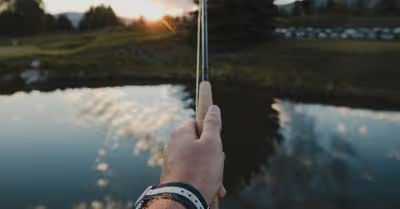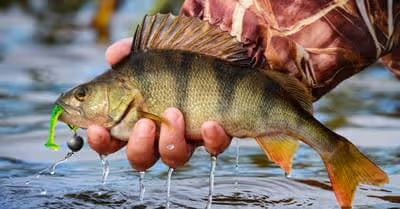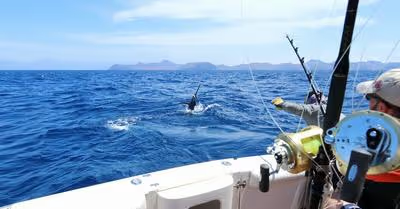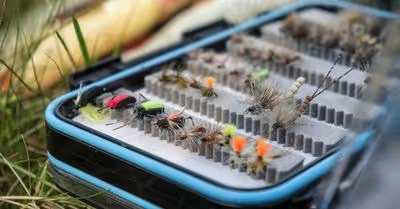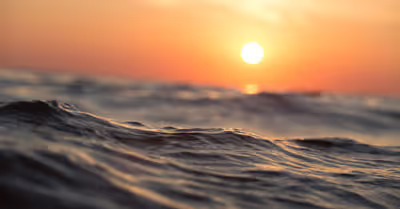Table of Contents
Types of Fishing Line
Being a seasoned angler, I understand that choosing the right fishing line can make a big difference in your success on the water. There are different fishing line types available in the fishing market, each with its own purpose and benefits. They include the following.
Braided Fishing Line
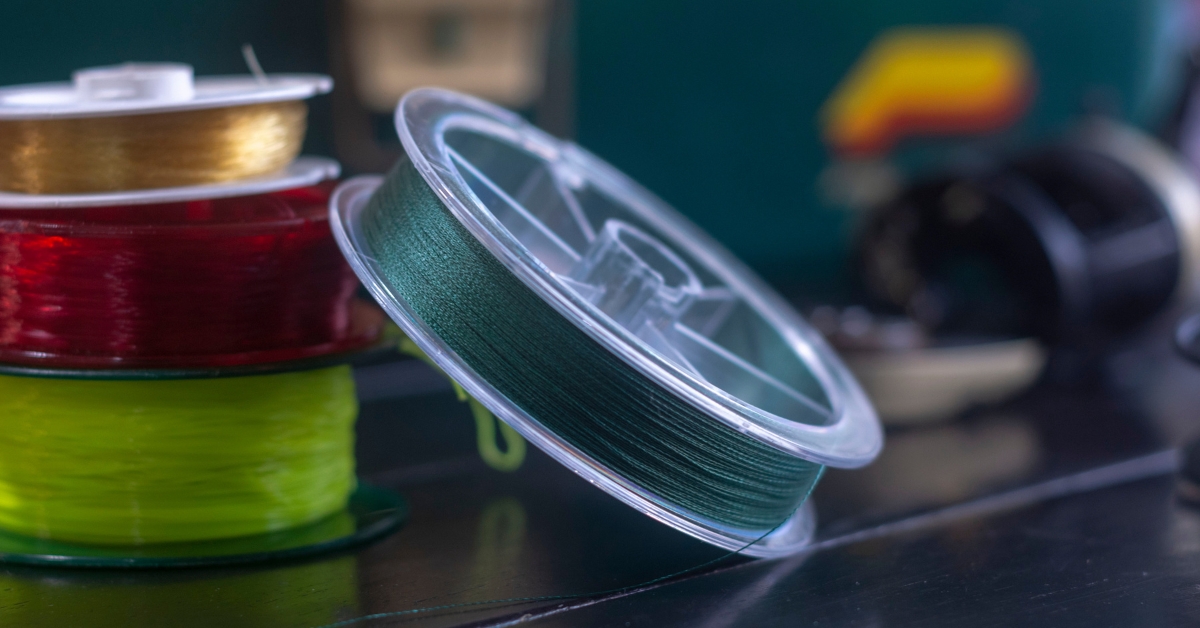
Braided Fishing Line
Braided fishing lines are known for their strength and durability. Made by weaving multiple strands of thin fibers together, these lines offer a high strength-to-diameter ratio, meaning they can handle heavy loads in a small diameter.
These lines are ideal for fishing in heavy cover or where abrasion resistance is needed. Some benefits of a braided line include:
- High strength and low stretch, which improves sensitivity and helps with setting hooks.
- Thin diameter, allowing for smooth casting and less water resistance.
- Superior resistance to abrasion and UV damage.
However, be aware that these tight lines are more visible in the water and may not be ideal for certain types of fishing where a stealthier approach is needed.
Fluorocarbon Fishing Line
A fluorocarbon line boasts a unique trait: it’s nearly invisible underwater due to its light refraction properties. This makes it the best fishing line for clear water situations or when targeting finicky fish that might be line-shy.
Some additional benefits of this high-tech fishing line include:
- High abrasion resistance, making it durable for fishing around structures.
- Sinks faster than monofilament lines, which can be useful when fishing with weighted lures or in deep water.
- Low stretch, providing better sensitivity and more solid hooksets.
However, fluorocarbon lines can be a bit more difficult to handle as they are stiffer and have a higher memory than other line types.
Monofilament Fishing Line
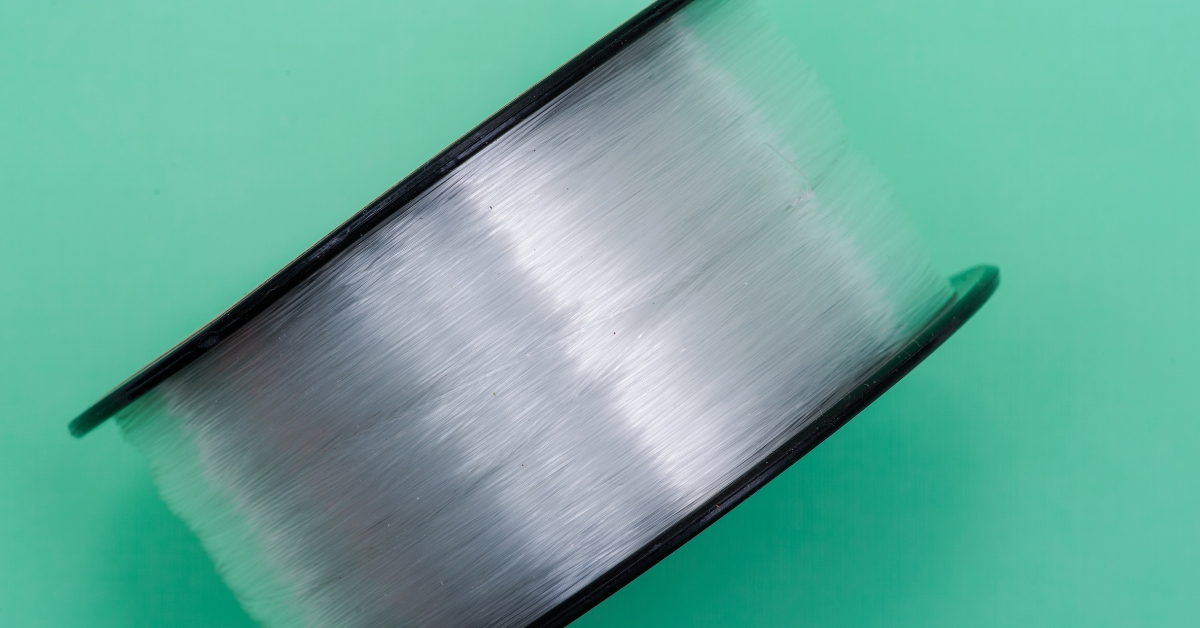
Monofilament Fishing Line
Monofilament fishing lines, often referred to as "mono lines," have been the go-to choice for most anglers due to their versatility and affordability. Made from a single strand of plastic, usually nylon, monofilament lines are easy to handle and work well in various fishing situations.
Some advantages of a monofilament line include:
- Good knot strength and ease of tying the knots.
- Superior shock absorption, which can help prevent break-offs when fighting strong fish.
- Available in various colors, allowing you to match the line to your fishing environment.
- It’s a light line.
However, these lines have some downsides, such as higher stretch, limited to very light tests, susceptibility to UV damage, and a tendency to coil and retain memory.
Other Lines
In addition to the main types of fishing lines, there are also other specialized lines designed for specific situations or techniques. These may include:
- Fly fishing lines: They are designed to work with fly rods and deliver lightweight lures.
- Lead core lines: They incorporate a lead wire for depth control, used in trolling.
- Hybrid or a copolymer fishing line. This line combines the properties of monofilament and fluorocarbon lines.
These specialized lines are tailored to the unique needs of certain fishing situations, such as saltwater game fishing, offering further options to enhance your angling experience. This video provides more information about the different types of fishing lines.
Choosing the Right Line
It’s important to choose the right fishing line for your specific needs. The type of line you select can greatly impact your success on the water.
Firstly, you need to consider the material of the fishing line. There are three primary types: monofilament, fluorocarbon, and braided. Monofilament lines are versatile and cost-effective, making them suitable for various fishing applications.
Fluorocarbon fishing lines, on the other hand, are nearly invisible underwater, making them ideal for clear water conditions and finesse fishing. Braided lines offer exceptional strength and sensitivity, which is perfect for situations with heavy cover.
The fishing conditions you'll encounter also play a crucial role in your choice of line. Factors like water clarity and temperature can influence your decision. In clear water, where fish may be more cautious, fluorocarbon lines can be advantageous due to their low visibility.
For coldwater fishing, lines with better flexibility in low temperatures are preferable. Conversely, warm water conditions may require lines with excellent abrasion resistance.
Your target species is another key consideration. Light lines are suitable for small or finesse fish species, while heavier lines are necessary for larger, hard-fighting fish.
Matching the pound test rating of the line to your target species' strength is essential. Additionally, think about the fish's feeding habits and behavior, as this can influence your choice of line color and visibility.
Lastly, budget considerations can't be overlooked. Fishing lines come in a range of price points. While quality is vital, your budget can play a significant role in your decision.
Monofilament lines are typically more budget-friendly, making them a suitable option for beginners or anglers who go through many lines. High-end fluorocarbon and braided lines offer premium performance but may come at a higher cost. Watch this video to learn more tips on how to choose the correct fishing line.
Fishing Techniques
As a dedicated angler, I recognize the crucial role that selecting the appropriate fishing line plays in achieving success across various fishing techniques. Let’s explore different fishing techniques that will enhance your overall angling experience.
Freshwater Fishing
In freshwater fishing, the most common fishing line types are monofilament, fluorocarbon, and braided lines. Monofilament is versatile, affordable, and easy to use, making it a popular choice for beginners.
Fluorocarbon has a lower visibility underwater and is more abrasion-resistant, making it suitable for fishing in heavy cover. Braided lines have excellent strength-to-diameter ratios, making them an ideal choice for fishing in thick vegetation, casting long distances, or fishing larger species.
Fly Fishing
For fly fishing, a unique line type called fly line is required. This specialized weighted line collaborates with the fly rod and reel to effectively propel the lightweight fly lure to the targeted fish location.
Fly lines commonly consist of synthetic monofilaments coated with advanced plastics, enhancing your ability to cast your bait with increased distance and precision.
Bottom Fishing
Bottom fishing involves targeting fish that dwell near the seabed. The best fishing lines for bottom fishing are braided lines and heavier monofilament. Braided lines provide higher sensitivity, allowing you to detect subtle bites while fishing at greater depths.
Monofilament lines, on the other hand, can provide more shock absorption, which is beneficial when dealing with strong currents or heavy sinker weight.
Inshore Fishing
Inshore fishing includes fishing near the coast, in bays, estuaries, and other shallow water areas. Fishing lines for inshore fishing should be versatile and resistant to abrasion caused by rocks, coral, and other underwater structures.
Fluorocarbon and monofilament lines are widely used for inshore fishing, while braided lines offer superb casting characteristics and sensitivity when targeting specific fish species.
Now, let’s see the main differences between these techniques in the table below.
Understanding Line Specifications
Fishing lines are a crucial component in the art of angling. With so many factors to consider, it can be overwhelming trying to decide which type of line is best for your needs.
We'll explore the key specifications and properties of fishing lines, such as line strength, memory, abrasion resistance, pound test, stretch, floating capabilities, color, knot-tying ease, and diameter.
Line strength and pound test are vital factors for choosing the right fishing line. Line strength represents the line's ability to resist breaking under tension, while the pound test indicates the maximum weight it can hold before breaking.
Smaller diameter lines often have lower pound test ratings, while larger diameter lines boast higher pound test and strength capabilities. This balance must be considered based on your target species and fishing environment.
Line memory refers to how well the line retains its coiled shape when it comes off the reel. A line with less memory is preferred, as it reduces the chances of tangling and improves casting performance.
Monofilament lines have greater memory than braided or fluorocarbon lines, which are generally more supple and tangle-resistant.
Abrasion resistance defines a line's ability to withstand wear and tear. Thicker lines with larger diameters tend to be more abrasion-resistant, making them suitable for fishing in environments with rocks, debris, or sharp structures.
Braided lines, despite their smaller diameter, also offer impressive abrasion resistance due to their woven construction.
Line stretch affects sensitivity and hook-setting power. Less stretch improves bite detection and provides firmer hook penetration, while more stretch offers shock absorption during fights.
Monofilament lines have the most stretch, whereas braided lines have the least, followed by fluorocarbon lines, which are somewhere in between.
Some fishing scenarios require lines that float, while others call for sinking lines. Monofilament lines generally float, making them perfect for topwater and shallow presentations.
In contrast, fluorocarbon lines sink, which is advantageous for deep-water techniques or when you want your bait to remain submerged.
The color of the line can impact its visibility underwater. In clear water, a low-visibility line such as fluorocarbon or clear monofilament is preferred. In murkier water or heavy vegetation, using a high-visibility line like braided or brightly colored monofilament allows you to track your line's movement more easily.
Lastly, the ease of tying knots is essential for securing hooks, lures, and other tackles. Monofilament lines are generally easier to knot, while fluorocarbon lines can be slightly more challenging.
Braided lines can slip when incorrect knots are used, but some specialized knots ensure a secure connection.
Fishing Gear
As a passionate angler, I constantly explore different types of fishing equipment to level up my game. Understanding the various aspects of fishing gear, such as rods and reels, is essential for a successful angling experience.
The right combination of equipment, paired with the proper line type, ensures that you're prepared for any fishing adventure. As such, I'll be discussing various aspects of fishing gear, focusing on fishing rods and spinning reels.
Fishing Rod
A fishing rod is the backbone of any angling experience. Its main function is to transmit the sensitivity of the lure and the bite and to provide leverage for casting and fighting fish. There are numerous types of fishing rods available, including fly rods, spinning rods, and baitcasting rods, among others.
Fly rods are specifically designed for fly fishing and are generally lighter, more flexible, and have a slower action compared to other rods. They are paired with specialized fly lines to accurately cast lightweight flies.
On the other hand, spinning rods are versatile and are easily paired with spinning reels, making them popular among anglers of all skill levels.
Spinning Reels
Spinning reels are an essential component of your fishing gear, as they help manage and store your fishing line while casting and retrieving. They are user-friendly, which is why they're highly recommended for beginners and casual anglers.
Among their many advantages, spinning reels allow for
- Smooth, accurate casting
- Effortless line management
- Adaptability to different line types, including high-tech fishing lines
However, keep in mind that spinning reels aren't suitable for all situations, so it's important to choose the right reel that meets your specific fishing needs.
Cultural Significance: Fishing Lines as Cultural Treasures
When I think about fishing, I can't help but appreciate the cultural significance of fishing lines across the world. In different regions and among various fishing communities, fishing lines have been integral to traditions, livelihoods, and cultural practices.
In traditional fishing cultures across the globe, different types of fishing lines have held both practical and symbolic importance. For example, in some communities, handcrafted silk fishing lines were passed down through generations as treasured heirlooms.
In other parts of the world, fishing lines made from plant fibers or animal sinew were essential to daily life, serving as tools for obtaining sustenance and teaching valuable life lessons.
Different materials and techniques were used to create fishing lines specific to each region's cultural and ecological context.
The use of natural materials such as plant fibers, hair, and sinew reflected a deep connection to the land and sea and created a bond between the people and their environment. This harmony between humans and nature is something that continues to inspire anglers.
Recent Articles





